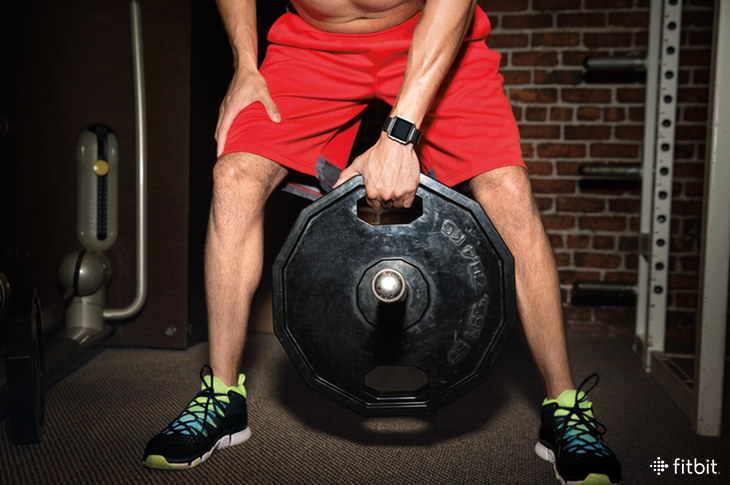
5 Questions to Ask Yourself Before Reaching for Heavier Weights
 You’re eating well, training hard, and still falling short of reaching your goals. You’re not alone—the dreaded fitness plateau is real! But loading on the weight isn’t always the answer. Listening to your body is key, but before you go heavy, it’s also smart to ask yourself these five questions.
You’re eating well, training hard, and still falling short of reaching your goals. You’re not alone—the dreaded fitness plateau is real! But loading on the weight isn’t always the answer. Listening to your body is key, but before you go heavy, it’s also smart to ask yourself these five questions.
1. Have you mastered your current rep scheme?
Repetitions (or reps) and sets exist for a reason—having a goal number of complete motions or group of consecutive repetitions in mind helps you know what to aim for and keeps you accountable. Before adding more plates to the bar or reaching for a heavier dumbbell, take a moment to assess your fitness. How are you performing with your current load? “If you’re doing three sets of 10, and your last couple of reps are doable but challenging—slow, strenuous, and likely to leave you short of breath—then you’re using the right amount of weight,” says personal trainer and running coach Meghan Kennihan. On the other hand, if you can only bust out 6 reps when you’re aiming for 10, strip the weight and start again.
You want to be challenged, but not at the risk of breaking proper form. Keep in mind, even when it comes to body weight, 100 bad push-ups aren’t as beneficial as 10 good ones.
2. Have you considered other avenues of difficulty?
According to Kennihan, there’s never a time when you should be able to easily tag on a few reps to your final set of 10. But what if the next set of weights available (say, a 5-pound jump from 10 to 15 pound dumbbells) makes the movement seem near impossible? “When you think you’re ready to increase weight, you don’t have to start with actually increasing weight,” she says. “If you fall extremely short of your goal—say you hit that first set of 10 and then can only hit a set of six before you must take a breather, you going too heavy.” Instead of sacrificing form—which could lead you to target the wrong muscle group or, worse yet, lead to injury—consider implementing shorter rests, slower tempos, or increased reps to make things more difficult. “Use your current weight to do 3 sets of 15 reps,” says Kennihan. “Once you’re comfortable with that, you should be able to move up to doing 3 sets of 10 with a heavier weight.”
3. How sore are you?
The saying “Sore, not sorry” only goes so far. “Typically, if you’re new to lifting, you are going to get some delayed onset muscle soreness within 48 hours,” she says. But, if that lasts more than a day or two, you went way too heavy. “Sitting on your butt three days in a row just to recover from one workout isn’t going to help you reach your goals,” she says.
4. Do you know why you’re adding weight?
“You never want to add weight to all of your exercises just for the heck of it,” says Kennihan. But when the weight you’re using is no longer challenging, it’s time to reconsider your goals. If you’re looking to gain strength, it might make sense to add a few plates to the bar to strengthen your squat. But integrating more reps into your training can also help you push past a plateau.
This holds especially true for targeting smaller muscle groups, such as triceps, which don’t require a lot of weight but can benefit from the muscular endurance—or getting used to more time under tension before fatigue sets in. Not having to carry the burden of added weight will also allow you to pay more attention to technique and ensure you’re targeting the correct muscle group. If you do decide to increase the weight, add it incrementally, prioritize form, and take notes to track your progress and provide motivation.
5. Is your current pace challenging?
Maybe it’s not about ramping up the weights or, in the case of cardio, increasing your overall speed. Before you make a huge leap, ask yourself if your current movement pattern is challenging enough. For example, if you’re used to talking on the phone while lifting slowly, or watching your favorite show while walking at a two-miles-per-hour pace on the treadmill, it might be time to rethink your strategy. “If you’re a walker, start progressing with intervals,” says Kennihan. “Start with 30 seconds of jogging before going back to walking for a minute. From there, increase the on-off ratio as you get more fit over time, alternating between 1 minute of walking and one minute of jogging.” The same goes for lifting. If you find yourself cranking out curls, slow down the tempo. The movement will feel more challenging, and working your eccentric muscles (the lengthening ones) to a greater degree might make you realize that increasing the weight isn’t even necessary.
Working out with minimal equipment? Bodyweight movements can also be made more challenging, sans added weight. Instead of placing a plate on your back to take push-ups to the next level, try using a more narrow hand position, add in some fancy footwork by integrating a plank jack, or simply lower your chest to the ground in a slow, controlled manner.
The post 5 Questions to Ask Yourself Before Reaching for Heavier Weights appeared first on Fitbit Blog.
Source: Fitbit Blog
—